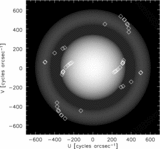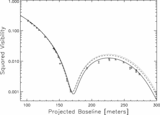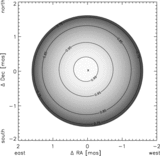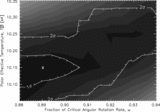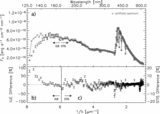Image Details
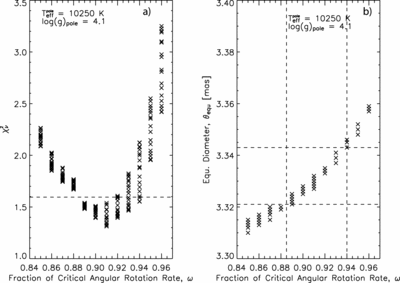
Caption: Fig. 6.
Constraints on model parameters from the CHARA/FLUOR data. (a) Reduced ﹩\chi ^{2}﹩ values ﹩\chi ^{2}_{\nu }﹩ from the Roche‐von Zeipel model fit to the squared visibility data as a function the fraction of the critical angular break‐up rate, ﹩\omega =\Omega / \Omega _{\mathrm{crit}\,}﹩, for fixed values of the polar effective temperature ﹩T^{\mathrm{pole}\,}_{\mathrm{eff}\,}﹩ and polar surface gravity ﹩\mathrm{log}\,\left(g\right)_{\mathrm{pole}\,}﹩. The dashed line denotes the 1 ﹩\sigma ﹩ confidence region for ﹩\omega ﹩ from the ﹩F﹩ test for 24 degrees of freedom relative to the best fit at ﹩\chi ^{2}_{\nu }=1.31﹩. For each ﹩\omega ﹩, ﹩\chi ^{2}_{\nu }﹩ values are plotted for 18 position angles ﹩\psi ﹩ (0° to 170° in 10° steps; see Fig. 4). (b) Relationship between the best‐fit equatorial angular diameter ﹩\theta _{\mathrm{equ}\,}﹩ at each ﹩\omega ﹩ for the range of position angles. The dashed lines provide an estimate for the 1 ﹩\sigma ﹩ range in ﹩\omega ﹩ and the corresponding range in the equatorial angular diameter.
Copyright and Terms & Conditions
© 2006. The American Astronomical Society. All rights reserved. Printed in U.S.A.


